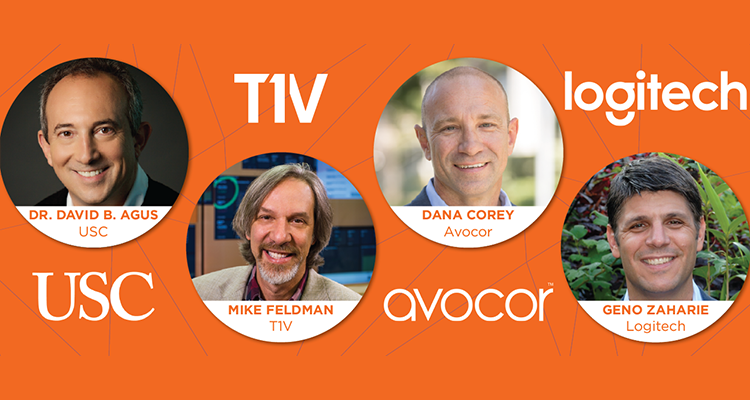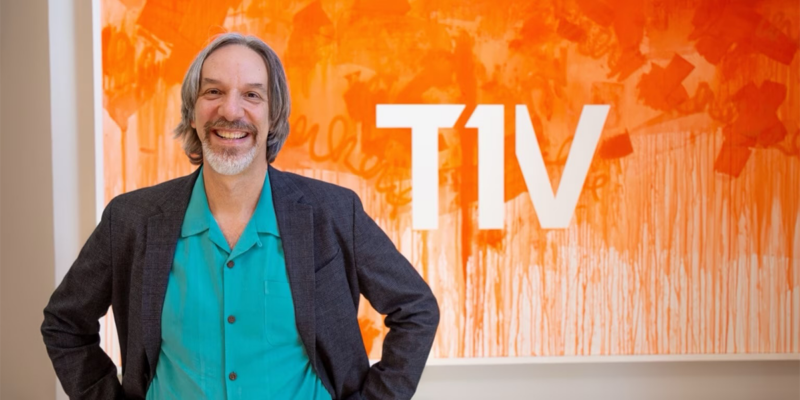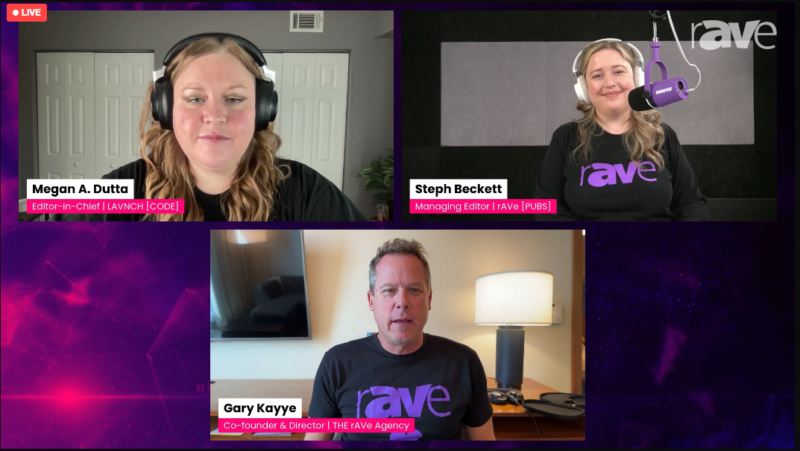COVID-19’s Impact on UCC: Learnings From T1V Panel With Dr. David B. Agus and AV Experts
Practically no one, and no community, has escaped the impact of COVID-19 on life and work. Underneath it all, we’re all just itching to know how long this will go on. On Thursday, T1V hosted a webinar to dig into these realities and tensions. To help, it enlisted one of the world’s leading physicians to answer some of our burning questions.
The topic? The impact of COVID-19 on unified communications and collaboration (UCC).

The visual-collaboration company’s timely webinar featured Dr. David B. Agus, CEO of the Lawrence J. Ellison Institute for Transformative Medicine of USC and contributor to CBS News. Also featured were AV industry execs Mike Feldman, CEO of T1V; Dana Corey, SVP and GM at Avocor; and Geno Zaharie, director of alliances and GTM at Logitech.
With a well-rounded group of panelists at the ready, the discussion commenced.
Opening thoughts from a leading physician
As both a medical expert and a T1V ThinkHub user, Dr. Agus is uniquely positioned to speak to COVID-19’s impact on collaboration. On workplaces and universities, Dr. Agus led with some opening thoughts: A lot of people in the medical field were talking pandemics before this, but few were acting on it. Until now.
Dr. Agus discussed the latest developments in the research of the virus, as well as vaccinations and treatment for it. He thinks there’s hope around the corner, but there will need to be some behavioral changes in the workplace and beyond. He thinks those changes will take at least a year to make and properly enforce. In the meantime, the focus will be on doing large meetings through videoconferencing and social distancing in the workplace and beyond. His perspective — it’s about multiple disciplines working together in a way that’s more than just using videoconferencing platforms like Zoom. The Ellison Institute, for example, uses T1V’s collaboration platform throughout the organization.
“The human brain wasn’t wired for Zoom,” Dr. Agus illustrated.
Humans work with cues. You can’t get those interactions through Zoom. The power of what T1V is doing, Dr. Agus added, is finding a way to materialize those interactions through technology. We’re getting up, walking around and showing things. Dr. Agus continued, “Our behavior is just going to have to change, no matter how you look at it.” Sure, we will always have virus in the world. But even with a pessimistic view, Dr. Agus thinks we’ll be able to better identify and trace individuals now instead of shutting down society. For now, he thinks the developments will be good enough to get us back to a “more normal” way of life.
What about trade shows?
The glory of trade shows is about who you meet in the hallway and the conversations you have that spark some of the most transformative ideas. Unfortunately, on large trade shows in 2020, Dr. Agus thinks nothing will happen this calendar year. He predicts that maybe toward the end of Q1 2021 (or potentially later on), if we’re all vaccinated and have proper safety strategies in place, trade shows could be possible again. We need solutions and ways to stay connected virtually in the meantime — and beyond.
And universities on campus?
There’s no one answer for campuses, as there are variances between schools and environments. Notre Dame, for example, said it’ll open in August and operate on a shorter schedule before a predicted second wave of the virus in cooler weather. Some universities are saying they don’t yet know and won’t risk it until they do. Others are somewhere in the middle. No matter what, though, there will be different interactions at universities come September.
How can classrooms adapt post-COVID-19?
In addition to distance learning — more students and professors accessing the classroom virtually — there will need to be other methodologies for large-entry classrooms. Dr. Agus argues that the more organic the interactions in remote learning, the more kids will trust it. Dr. Agus added, “The fancier it is, the less people will respond.”
Geno Zaharie offered his perspective from the lens of hardware manufacturer Logitech: As educators, we’ll need to create a more rich, engaging and immersive environment for those on the far end. Back in the day, the challenge was how to mic up a whole classroom. Now, it’s the reverse. It’s not difficult to put microphone technology in the right place, or provide multiple cameras to provide multiple viewpoints — we already have the technology and tools to do it. We just need to think about, when classrooms are reinvented, how the tech will be sent to those on video on the far end. How do we take the current classroom environments and create a production out of our lesson plans? How do we capture everything possible and send it to the other end? It’s not too hard to do, Zaharie added. It’s a matter of putting a plan together to do it.
Mike Feldman added that this shift in classrooms was already happening before COVID-19. It’s called active learning. Students used to come in and professors would lecture to a giant hall — it wasn’t the most productive way to teach or learn. Now, teachers give lessons, then students try it and practice it for themselves. With some students at home, some professors teaching remotely, fewer students in each room, teachers teaching to multiple rooms and students spread out more, it all needs to get linked together. Face-to-face classroom learning will still be important and relevant — and it will come back. It’ll just look a little different when you add in the remote side of things. Our goal is to make it as close to reality as we can.
How will travel restrictions impact the way global teams connect and collaborate?
Travel will be limited over the next year, Dr. Agus says. It’s twofold: certain countries won’t want visitors necessarily, and visitors won’t want to travel as frequently. We’re starting to question what travel is necessary in the first place? At the same time, many have to do some travel. So it’ll be a hybrid and a different experience, with a new focus on health.
Dana Corey added that, if we can’t meet, we’ll have to find new ways to be more productive. Many are video-fatigued right now — video call after video call is mentally draining. There can be better productivity through solutions like T1V, which allows you to work from anywhere, make the most of your space and go beyond video. We’ll also need to generate business outcomes and engagements (no matter the department) with our current tools, bringing those tools to the right place at the right time. Persistence of data (not just a meet-and-forget type deal) will be key — the continuous evolution of data/sharing will require the cloud. Take notes; have outcomes. Save it; refer to it later.
How can workplaces adapt now? A year from now?
As a result of COVID-19, Dr. Agus shares, companies are more obliged to measure productivity while folks are at home. (How much got done? When we do meetings a certain way, how productive is it? What’s the mental/physical state of the employee currently?) To do this, groups should continue collecting data and implementing feedback loops in our new way of doing business.
Corey joked that if he knew the answer to this, he’d be planning it right now. He adds that Avocor prides itself on company culture — how do you generate that when so much of your workforce is not in the building? Developing camaraderie when you’re not together will be tough, but it should be top of mind. Find ways to engage in and create culture where you can.
There’s both near-term steps and long-term ones, Zaharie pointed out. The immediate step is to make students and employees feel safe and secure going into facilities. We need welcoming building and facility culture, as well as small-team culture and all-company culture. Longer-term, it’s a question of how we put the right tech into rooms (under new social-distancing guidelines) to help build an experience that’s desirable.
Q&A + Takeaways
An audience Q&A dug into some additional questions — topics included privacy with new technologies like temperature-scanners; supporting K-12 classrooms and students; wearing masks at work (Dr. Agus is a big proponent of this, because if it stops the spread and prevents death, why not wear them?); cleaning screens and technology (Dr. Agus adds that it’s safe to continue using touch screens, by the way, as the industry develops protocols and standards around cleaning); how the virus spreads via surfaces versus droplets; how COVID-19 will compare to the flu from a vaccination standpoint; and how certain regions and industries globally are more susceptible than others.
Of course, many of our initial questions may still remain. But we must realize we have yet to see much of this shake out. Optimism exists, and T1V’s webinar is a great example of how we can continue sharing accurate information among each other. Importantly, companies should be on their toes to avoid falling behind as things change. It will certainly depend on the business, location and industry. But no doubt, life and work will look a little different 2020 and beyond. Being prepared matters, and great companies will adapt. Choosing future-proof and platform-agnostic tools, better using the tools you already have at your disposal, and finding good partners who aren’t afraid of change are three strategies AV integrators and teams can take right now.
You can register to review the recording of T1V’s webinar here and see T1V’s additional upcoming webinars here.





